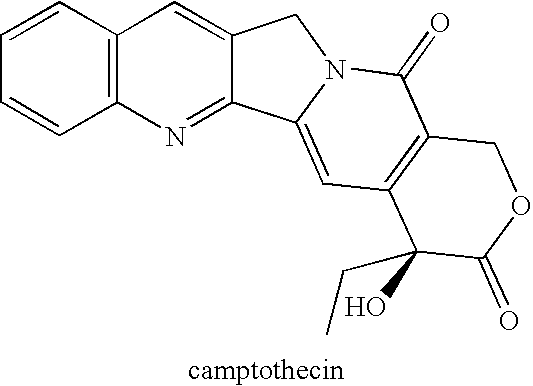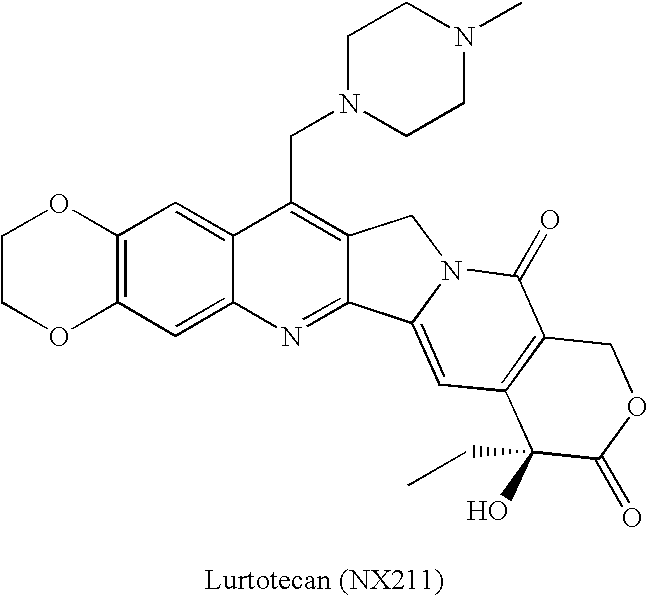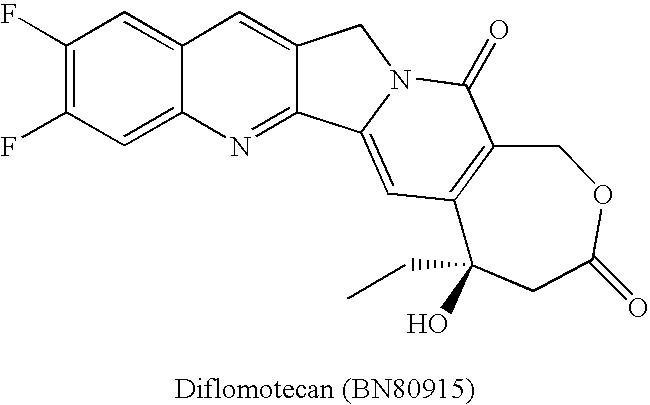By the early 1970's, CPT had reached Phase I and Phase II clinical trials and although it was found to possess anti-tumor activity, there were numerous deleterious physiological side-effects associated with its use.
These toxicities, found during early clinical studies, rendered the drug “unmanageable” during this time period.
However, it was subsequently established that this formulation resulted in
hydrolysis of the
lactone E-ring of the camptothecin molecule, thus forming the
water soluble carboxylate form of CPT which only possessed approximately one-tenth or less of the anti-tumor
potency of the original, non-hydrolyzed
lactone form of CPT.
The clinical trials performed using the
sodium hydroxide-formulated CPT provide to be highly disappointing, due to both the frequently-observed significant systemic toxicities and the lack of anti-neoplastic activity.
This low
aqueous solubility of CPT in the lactone form greatly limited the practical clinical utility of the drug because prohibitively large volumes of fluid had to be administered to the subject in order to provide an effective
dose of the drug.
Since normal
DNA is super-coiled, and tightly fitted in the chromosomes, the
DNA-replication fork is unable to synthesize new
DNA out of this topological constrained DNA.
Topo I acts in an ATP-independent fashion, by binding to super-coiled DNA and cleaving a
phosphodiester bond, resulting in a single-strand break.
These breaks may lead to
cell cycle arrest in the S / G2-phase, activation of
apoptosis pathways, and finally to
cell death.
As a result of this, Topo I inhibitors are only lethal in the presence of ongoing
DNA replication or
RNA transcription.
Because the S-phase is a relatively short phase of the
cell cycle, longer
exposure to the drugs results in increased
cell killing.
As discussed above, CPT and many of its analogs (see e.g., Wall and Wani,
Camptothecin and Taxol: Discovery to Clinic-Thirteenth Bruce F. Cain Memorial Award Lecture
Cancer Research 55:753-760 (1995)) are poorly
water soluble and are reportedly also poorly soluble in a number of pharmaceutically-acceptable organic solvents as well.
An additional major problem with 9-aminocamptothecin is that its
chemical synthesis using the semi-synthetic method is performed by
nitration of CPT, followed by reduction to the amino group, which is a very low yield type of synthesis.
9-aminocamptothecin is also
light sensitive,
heat sensitive and
oxygen sensitive which render both the initial synthesis and subsequent stability (i.e., shelf-life) of 9-aminocamptothecin problematic, at best.
Moreover, the
chemical decomposition reactions of 9-aminocamptothecin frequently result in the formation of analogs that exhibit a large degree of
toxicity in nude mice, whereas pure 9-aminocamptothecin is significantly less toxic.
As previously discussed, 9-aminocamptothecin is also difficult to administer to subjects because it is poorly soluble in both aqueous and organic solvents.
Alternately, while 9-
nitrocamptothecin is easier to produce and is more chemically stable, the
chemical conversion to 9-aminocamptothecin causes the drug is reportedly susceptible to MDR / MRP tumor-mediated
drug resistance, which further limits its utility in the unfortunately common setting of drug resistant neoplasms.
Further, its poor
solubility diminishes the amount of the drug that can cross the blood / brain barrier.
Having multiple drug-related human deaths and serious patient
toxicity, is clearly a failure of the aforementioned 10-substituted camptothecins synthesized by Miyasaka, et al., to fulfill their stated objectives.
Since the amount of
Irinotecan™ and SN38 metabolized is not predictable in individual patients, significant clinical limitations are posed and create the risk of life-threatening
drug toxicity, and / or risk of drug inactivity due to five putative biological mechanisms: (i) conversion of greater amounts of
Irinotecan™ to SN38; (ii) inactivation of SN38 by glucuronidation; (iii) conversion of SN38
glucuronide to free SN38; (iv) lack of anti-neoplastic activity due to the conversion of lesser amounts of Irinotecan™ to form SN38; and (v) lack of anti-neoplastic activity by more rapid and extensive conversion of SN38 to form the
glucuronide species.
It is important to note that even a doubling of the
plasma concentration of the potent Irinotecan™
metabolite SN38 may result in significant
toxicity, because free SN38 exhibits anti-neoplastic activity at nanomolar concentrations.
Deglucuronidation of a CPT analog that is susceptible to A-ring glucuronidation, such as SN38, results in an increase in the
plasma or local tissue concentration of the free and active form of the drug, and if high enough levels were reached, patient toxicity, and even death may result.
Poorly water-soluble (i.e., hydrophobic) camptothecins are necessarily formulated for administration by
dissolution or suspension in organic solvents.
These investigators also reported that the more prolonged schedule produced more
severe toxicity at a given
total dose level, but the difference was not as great as might have been predicted by preclinical animal studies.
These investigators concluded that CPT, at least as administered in this study, had little to offer the patient with advanced disseminated
melanoma.
These investigators state that the toxicity of CPT has been widely and unpredictably variable in the course of initial
clinical evaluation.
Second, is the rapid intravenous administration of the drug.
“push” or rapid i.v. infusion) times in all of these studies do not allow a long enough
exposure time to the drug at suitable levels, and is further compounded by the administration of the
water soluble carboxylate form of CPT.
 Login to View More
Login to View More 


